


4th Battalion, 20th Engineers
The Fourth Battalion
Note: Most of the text of this article comes from "TWENTIETH ENGINEERS -- FRANCE -- 1917-1918-1919"
The 4th Battalion was authorized on September 28, 1917, by a communication from the Chief of Staff to the Chief of Engineers. The nucleus for the companies was drawn from the personnel of the 3rd Battalion which was trained at Camp Belvoir, now Camp Humphries; Virginia. The first recruits for companies D,E, and F of the 4th, consisted of about 75 men each from A, B, and C of the 3rd Battalion, plus about 100 men who had recently arrived at Washington and had never reached their destination in the 3rd. The contingent from Belvoir arrived at American University, November 20th, and organization, equipping and drilling were started immediately. Owing to scarcity of clothing, recruiting had temporarily stopped for the 3rd and 4th Battalions, which were given clothing priority over all other American troops except those listed to sail overseas in October. Supply conditions rapidly improved and the companies of the 4th reached strength by November 27. By about the end of the month were each 90 men over strength, orders having come for each company to bring to France 83 men to reinforce the 10th Engineers and to bring them up to the newly authorized war strength of 250.
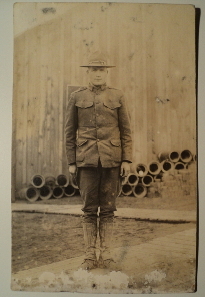
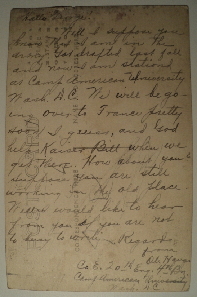
A post card written by "Ole Hauge" (Company E, 4th Battalion) to a friend, from Camp American University
Hikes, drills, fatigue duty, measles, mumps, changes of living quarters, extremely cold weather, and persistent rumors of departure marked the days of waiting for sailing orders, but a number of items of equipment were delayed, and Christmas came with no definite news. Finally the barrack bags were checked out, visitors were forbidden entrance to camp, and marched out of the University grounds at 12:30 A.M. on the morning of January 3, accompanied by a snowstorm.
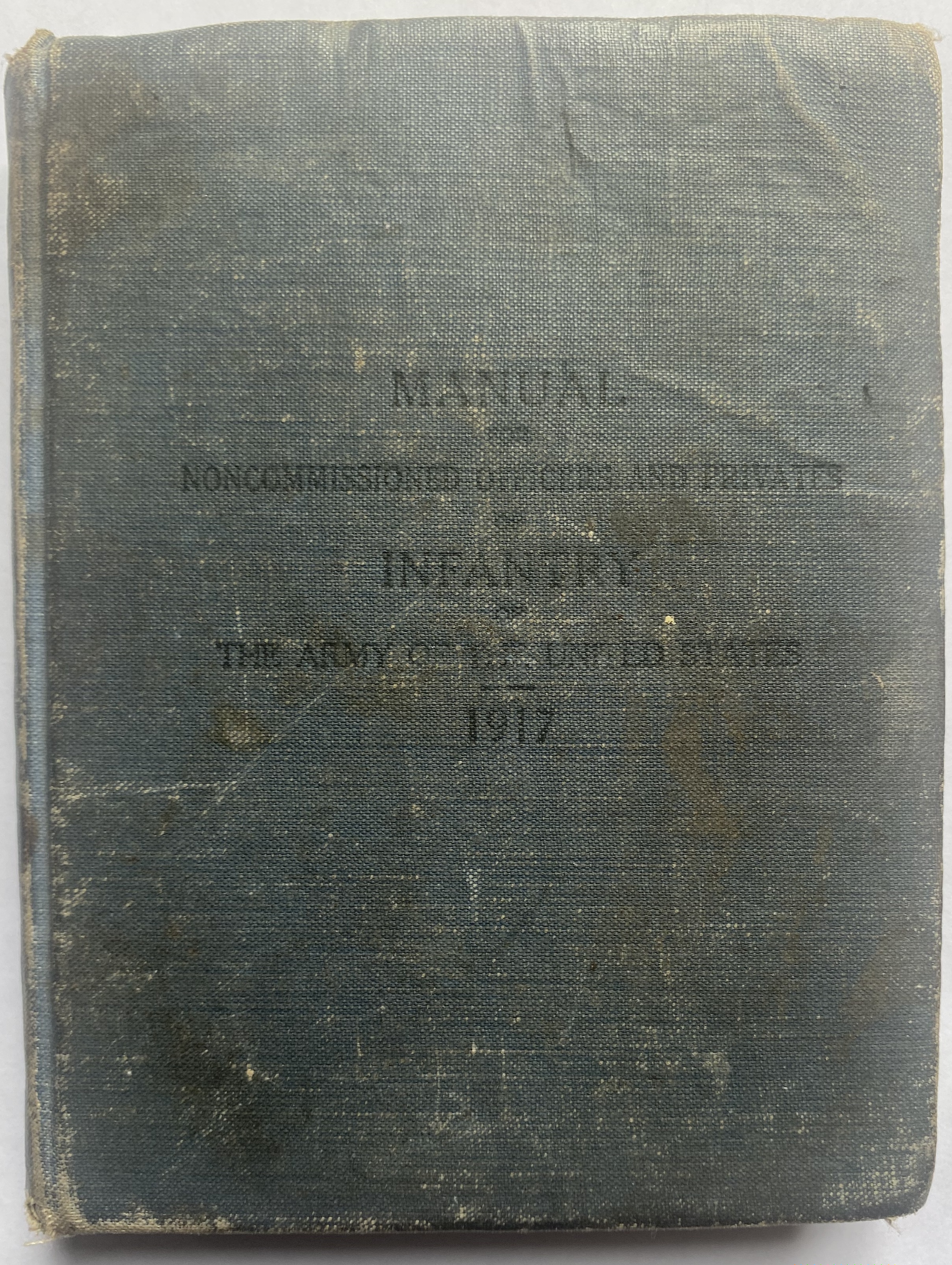
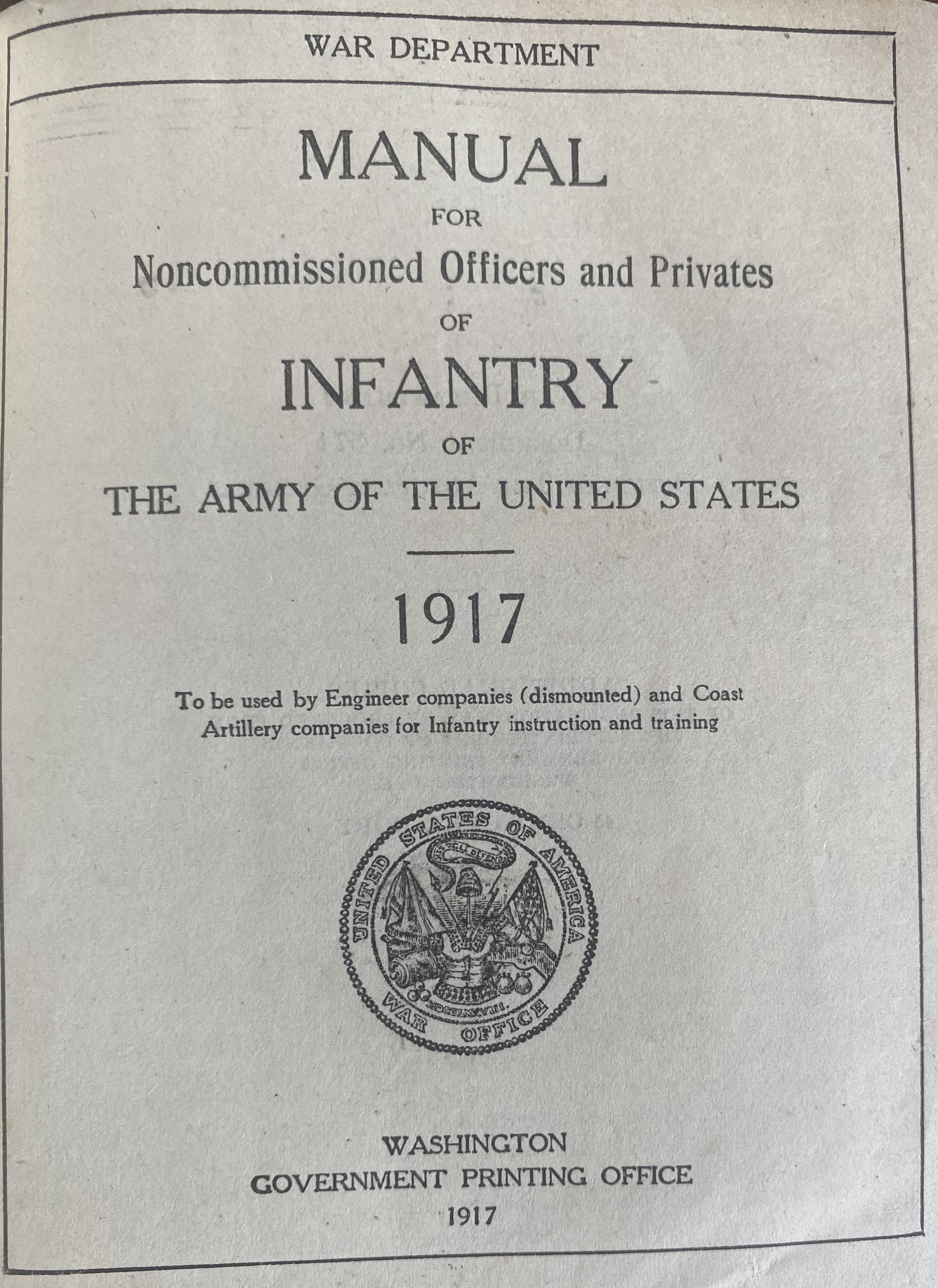
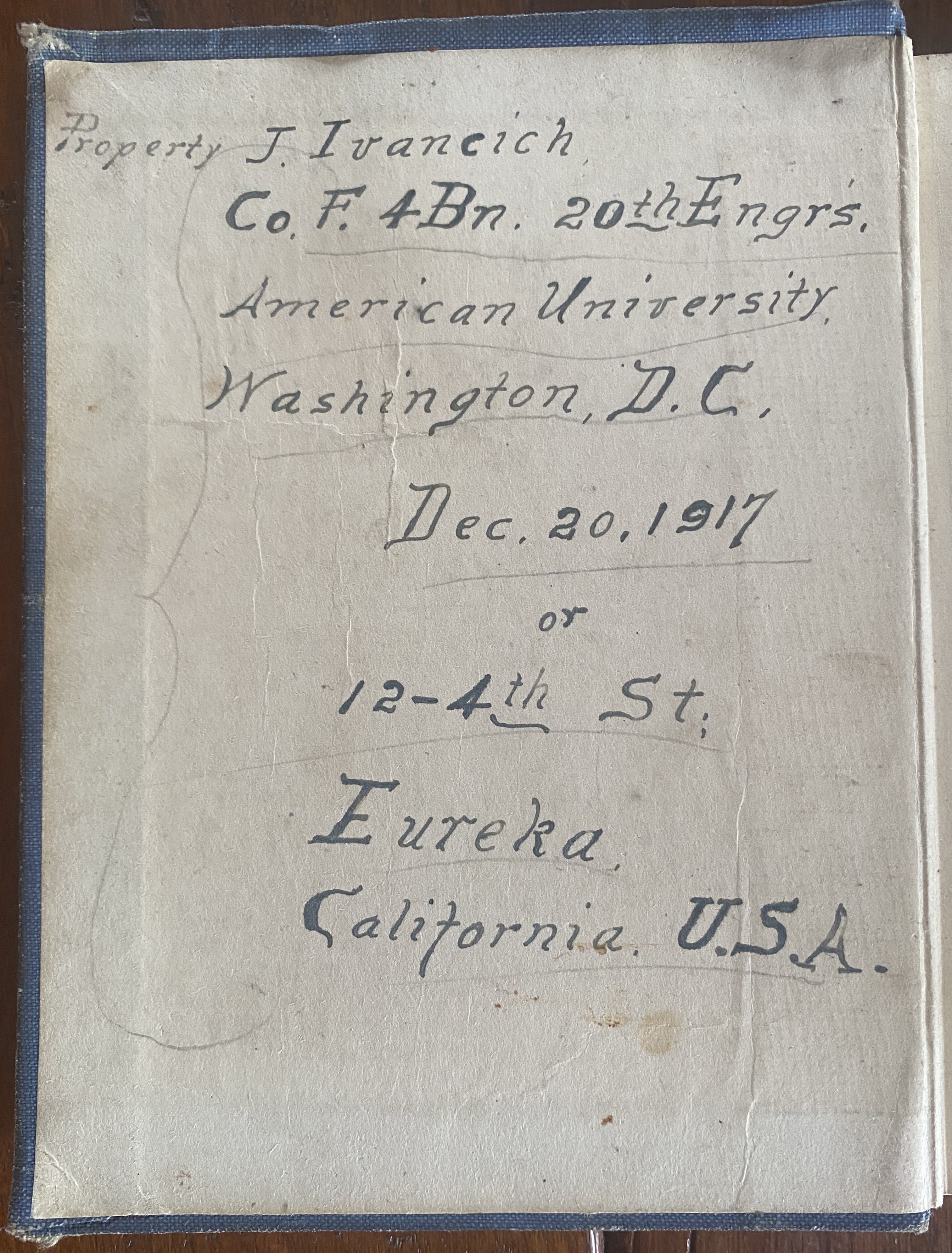
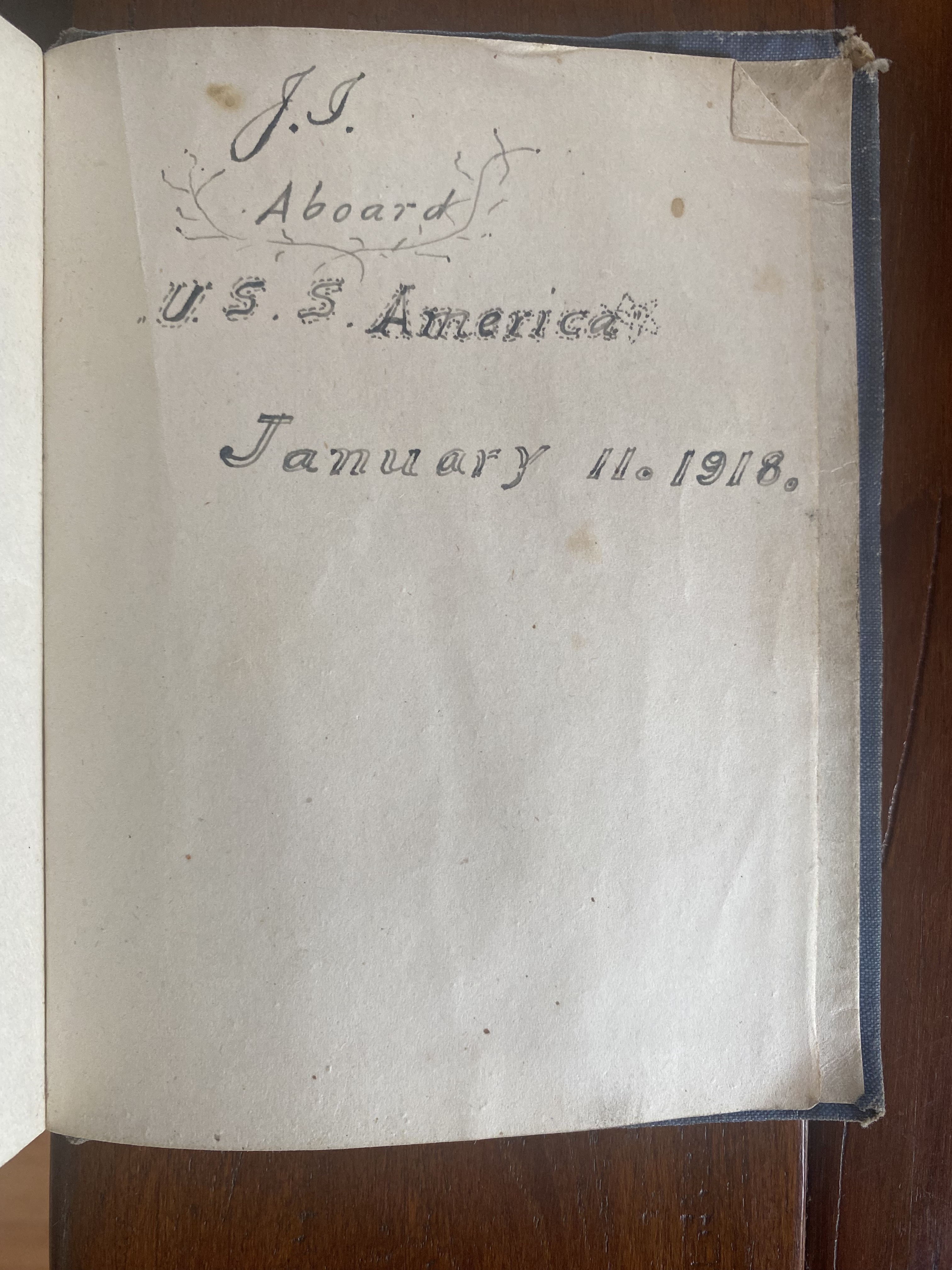
A training manual carried by Jacov Ivancich, Company F, 4th Battalion, 20th Engineers
January 4 the "USS America," carrying, among other troops 1,956 men and 44 officers of the 3rd and 4th Battalions, started down the river bound for France. For the greater part of the trip, the transport "Mercury" and the cruiser "Seattle" accompanied the "America" which enjoyed one torpedo scare before the destroyers arrived and protected her passage into Brest, which was reached January 17, after 13 days on the Atlantic Front. The 4th Battalion disembarked January 20th, and passed a short period of quarantine in the old Napoleonic barracks of Pontanezen.
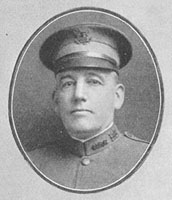

Major George H. Kelly, commander of the 4th Battalion, 20th Engineers
Click the photo for an article he wrote for The Timberman
Great article and wonderful photos!
Very soon after landing, D Company entrained for Marchenoir (Loir-et-Cher), under the command of Lieut. Conklin. The separation was pathetic, in that D yielded its talent in the battalion band to E, in exchange for more utilitarian personnel. The Headquarters Detachment, with companies E and F, took station in the Landes, south of Bordeaux, on the pine clad sand dunes bordering the Bay of Biscay. Headquarters was established at Mimizan-les-Bains in a villa bearing the suggestive legend "Sans Souci" (Without Trouble) above the door. E Company went into camp at once at Lamanchs, a mere loading point for turpentine and lumber 3 miles north of the beach resort and Company F found a similar location at Pleyres, 3 miles further north.
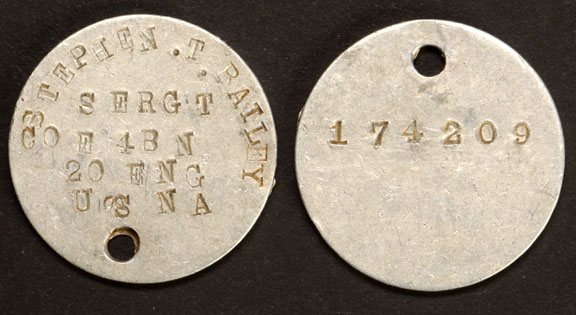
Dogtag belonging to Sergeant Stephen T. Bailey, Company E, 4th Battalion
Both companies erected 20-M mills, following a few months with small French machines, and some very good cuts were made, although no regimental records are credited to the district. At the time of greatest demand for ties, many of the men hewed on their own time after supper. The hand made ''haywire harness'' of E Company became famous throughout the regiment and the same outfit had the doubtful distinction of taking the only prisoner captured in the district, a poor native who was caught boot legging in camp after taps. The influenza was very severe in the region and one of the men, Corporal Charles J. Cumiskey, was recommended for a Distinguished Service Medal as a posthumous reward for his services in serving the sick men in the epidemic which claimed him as a victim after he had exhausted his strength in saving the lives of others. Baseball was played with neighboring outfits and on three occasions the district sent athletic teams to Bordeaux, where Sergeant Sisson took the honors of the Base Section in two events.
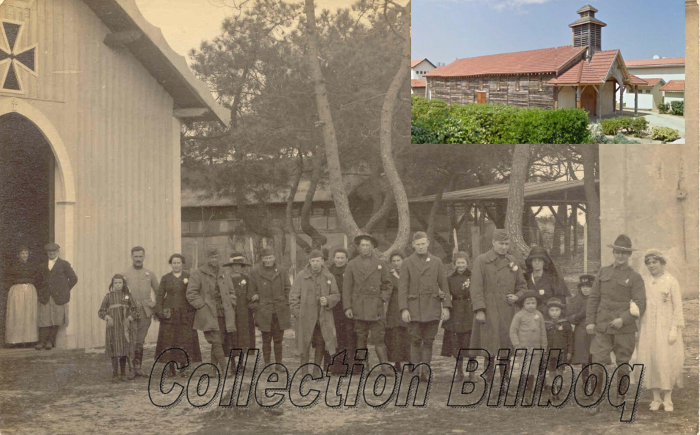
Courtesy of Michel Bouquet of Mimizan-les-Bains, France.
The postcard portrays the wedding of Charles F Balzer, 12th Company, to Marie Duverger on February 11th, 1919,
during his duty in the burnt area, at Pontenx-les Forges. Charles Balzer stayed in Mimizan
after his wedding. His daughter who is leaving in Mimizan is 94 years old (as of February 2016).
The color inset shows the church as it exists today. Villa Sans Souci is shown behind the church.
About half of Company E of the 8th Battalion joined the district and the first of June a detachment of Co. D, 42nd Engineers, was distributed among the companies. July 30, the Mimizan District reached its maximum strength by the addition of Co. C, 519th Engineers (colored), which built camp at Bias, several miles southeast of Mimizan-les-Bains, and erected a mill of its own.
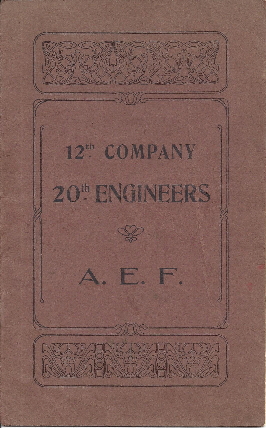
Roster for 12th Company (Company F, 4th Battalion)
Includes a short history of the unit and a memorial for those who died in service
Contributed by Adam Crouse, great-grandson of James L. Randle of 12th Company
July 4th the district joined with the Pontenz companies of the old Tenth in a big celebration at "The Bains," with boxing and wrestling as the main attractions. From time to time short leaves were [authorized which] allowed the men to go to Arcachon, a beach resort near Bordeaux, and a few who were afflicted with rheumatism or the epidemic "French Itch" had the privilege of the mud baths at Dax. For the most part, seven day leaves were enjoyed in the Pyrenees area, although some of the men were sent to Mont Dore and the area in Brittany, and a very few to Aix les Bains.
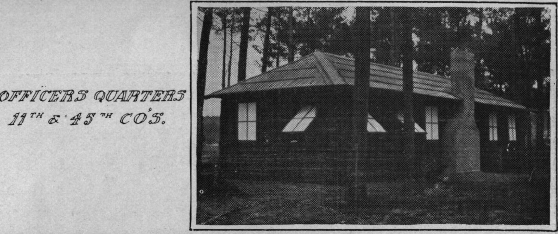
Officers Quarters of the 11th and 45th Companies
Meanwhile Company D came under the command of Lieut. (later Capt.) Richardson. This company established a record with a 10-M mill in hardwood, of 55,539 feet in 20 hours. It held to its job at Marchenoir steadily for 14 months, the greatest break in the monotony of operations occuring when 89 men were in hospital at one time, suffering from what was finally diagnosed as malnutrition.
Upon winding up affairs at Machenoir, the company rejoined the rest of the battalion in the Landes. They arrived in the camp of the 11th Company (E) at Candale, located 6 miles from Dax, on April 15, 1919, where close order drill and a general military resuscitation, necessary to pass the vigilant Inspector General, was had in preparation for home going.
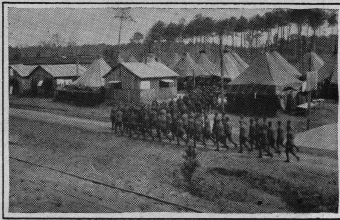
The 11th Company at its last drill, at camp in Candale
After the Armistice, the companies in the Mimizan District inspired by the report, (credited to the erstwhile co the battalion, Lt. Col. Kelly) that they would sail for home January 15th, hastened clean up work, but just as they were "ready" orders came for the 12th Company (F) to join the vanguard of the Burned Area Brigade. The company tore down its mill at Pleyres, rebuilt it in the Burn, and waited their for the final jump off for Bassens and Home, May 8th. The 11th Company took over the 10th, 11th, and 12th Company operations as a quiet sector, and a little later extended its front to the 33rd Company mill on Lake Aureilhan. Later the 11th was relieved by companies of the 1st and 2nd Battalions, and on April 2nd it entrained with the Headquarters Detachment for the old 1st Battalion camp near Dax, where the men sawed 1st Battalion ties until the first of May.
Battalion Headquarters and the 11th and 23rd Companies left for Bordeaux May 8th;
picked up the 12th Company on the way; and the 4th Battalion, reunited after 16 months,
sailed for home on the U. S. S. "Zeelandia" on May 11th, exactly half a year after
the Armistice. Debarkation was at Newport News, Virginia, May 23rd, and final dissolution
took place at Camp Alexandria.

The 12th Company on May 25, 1919, shortly after returning to the United States
Click on the photo to see close-ups
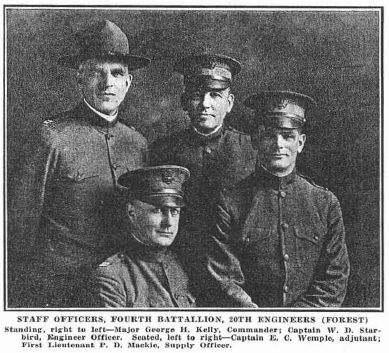
Battalion Staff - 4th Battalion
Battalion Commander - Major George H. Kelly
Engineer Officer - Captain Winfield D. Starbird
Adjutant - Captain Edwin C. Wemple
Supply Officer - First Lieutenant Paul D. Mackie
Company D
Company Commander - Captain R. B. Carter
First Lieutenants - W. G. Conklin, Ralph H. Faulkner and Alfred D. Kettenbach
Second Lieutenant - Fred A. Roemer
Company E
Company Commander - Captain Andrew J. Fisk
First Lieutenants - Lester W. Jacobs, Henry F. Power and Frank Mizeil
Second Lieutenants - Luther B. McDaniel and W. A. Foster
Company F
Company Commander - Captain Stephen C. Phipps
First Lieutenants - William G. Howe, John Summerset and Milton Pittman
Second Lieutenant - Harry H. Miller
Medical Detachment
Battalion Surgeon - Captain Frederick C. Moor, M. R. C.
First Lieutenants - First Lieutenants Leroy A. Schall, M. R. C., Joseph C. Kimball, M. R. C., and and John W. Snyder, D. R. C.